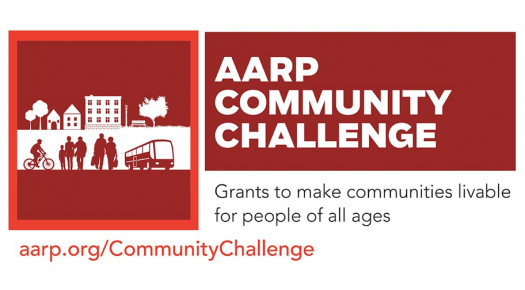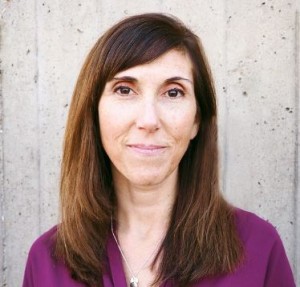A Placemaking Journal
Better Places for Changing Populations: AARP has some ideas
 Between now and April 17, AARP, the largest advocacy organization for seniors, is inviting government entities and non-profits to apply for a Community Challenge grant. This program, now in its third year, is a good one. Not just for retirement-aged crowd, and not just for the support it provides for individual projects.
Between now and April 17, AARP, the largest advocacy organization for seniors, is inviting government entities and non-profits to apply for a Community Challenge grant. This program, now in its third year, is a good one. Not just for retirement-aged crowd, and not just for the support it provides for individual projects.
The grants encourage recognition at the community level of the sense of urgency shifting demography requires. And perhaps even more importantly, the program prods communities to shape and implement components of a must-do list for the must-face changes coming their way.

The grants are intended, says AARP’s online invitation, to target “quick-action projects that can help your community become more livable.” They are “small grants to improve housing, transportation, public space, smart cities and other community elements.”
AARP had me at “small” and “quick action.”

Danielle Arigoni, AARP
“We know that sometimes it takes a visible demonstration of a new idea to really galvanize concepts, spur excitement, and attract new supporters to get behind change,” says Danielle Arigoni, director of AARP’s Livable Communities Initiative. “That’s why we kicked off the Community Challenge program in 2017 with a focus on QUICK action. Our grants are generally funded within two to three months of the application being submitted, and we require that grantees complete their projects within four to five months of award.”
Last year, the grants spread $1.2 million over 129 projects. Taken together with the requirement that a project must demonstrate success within a few months, the limited funding imposes discipline to align vision, planning, and implementation cost-effectively. Bang for the buck, in other words.
And because the rules also prioritize proposals that increase the likelihood that an awarded small effort is an incremental step towards something with bigger community impacts, grantees are rewarded for leveraging the biggest little thing they can do right away.
This is a strategy we’ve been promoting relentlessly in this space. Here and here, for instance. It may be the only winning approach in cynical times.
“That kind of fast, catalytic investment has made a huge difference to a lot of communities,” says Arigoni, “and helped them demonstrate and build success for bigger efforts around placemaking, public space activation, bike/pedestrian enhancements, transit enhancements, and housing.”
For a list of projects funded in 2017 and 2018 grant cycles, go here.
“There is just no substitute for people’s ability to touch, feel, and see new ideas in action,” says Arigoni. “It’s easy for people to cast doubt on the transformative power of placemaking, particularly when they have come to accept their street network, their home, and their local public space as either the natural result of decline, or just the way it’s always been.
“To convert an unused alley into a well-lit common gathering space with string lights, mural and café tables, or an underutilized parking area into an intergenerational garden with raised beds, or the plaza in front of a local library into a musical park that invites people of all ages to make music together — well, that’s more convincing about the power of change than any article, speech, or proclamation.”
An additional bonus: The awarded projects, says Arigoni, tend to “cultivate partnerships across unlikely groups that outlive our small grant, and form the basis for longer-term change, and better mutual understanding.”
That would be a pretty good thing, given the current challenge of cultivating anything other than enmity, whether we’re talking debates in Washington or on local city council meetings. Seeing seniors in the vanguard of placemaking changes might be especially tough for elected officials and planning staffers who are accustomed to looking out on crowds lining up to oppose just about anything that threatens the status quo and seeing lots of gray hair. But the status quo is increasingly unsustainable. The impact of an aging population may be the ultimate unkickable can.
“Simple demographic realities confronting us as a nation sometimes create that common ground,” says Arigoni. “When people learn that by the year 2035, we will have more older adults than children, it’s a real wake up call to think about whether our communities are ready, and what we can all collectively be doing better.
“Recently,” says Arigoni, “our state office in Minnesota scored a major win by jumping into the fray around the MSP2040 Comprehensive Plan,” which ends zoning that restricts neighborhoods to only single-family detached homes.
“It isn’t that single-family homes aren’t great,” says Arigoni. “The Twin Cities just has an overabundance of them, they realized, and they need to re-focus their energies to diversify the housing stock, increase supply, and make housing more affordable. AARP in Minnesota was front and center in the campaign to educate people about the options — and we’re delighted the plan passed.”
Even more dramatic is the entry of California’s AARP organization in the state’s fierce debate over affordable housing. There, AARP has thrown in with the YIMBY’s, the Yes In My Backyard contingent pushing for higher density and a broader array of housing options near transit. (For an informative analysis of that debate and its implications beyond California, see Miriam Axel-Lute’s Shelterforce piece.
Laura Foote, executive director of California’s YIMBY Action, provided a compelling welcome to the AARP in a recent Curbed piece.
“Despite a lot of the rhetoric about older homeowners blocking housing, I think this recognizes that often older people feel just as trapped and stifled by the housing shortage as anyone else. Too many older people feel trapped in homes that don’t make sense for their lifestyles anymore but aren’t able to scale down to an apartment in their neighborhood. It’s hard to age in place and maintain friendships in your community if it’s either maintain a suburban household or move to an assisted living facility. AARP knows that so many older people want their kids, their friends, people in healthcare, and everyone in their lives to be able to live in their communities. What is the point of aging in place if it means watching everyone you love have to move away?”
In the next two decades, expect to hear that argument in a lot more communities. And AARP, through its Livable Communities Initiative, has been stockpiling research, case studies, and how-to advice to support informed advocacy. For instance:
- The Livable Communities Initiative home page, with links to an array of resources and programs, including the Community Challenge Grant opportunity;
- Making Room: Housing for a Changing America, a report, produced in partnership with the National Building Museum, that lays out the demographic realities;
- And a helpful set of slides from the Making Room report.
If PlaceShakers is our soapbox, our Facebook page is where we step down, grab a drink and enjoy a little conversation. Looking for a heads-up on the latest community-building news and perspective from around the web? Click through and “Like” us and we’ll keep you in the loop.


